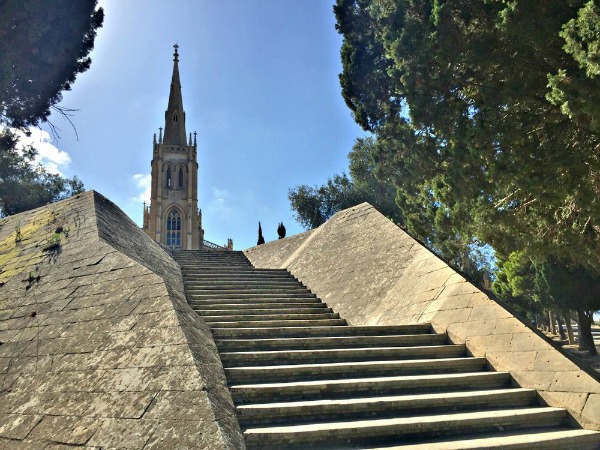Admiring Neo-Gothic Addolorata Cemetery
At this time of the year we celebrate All Saints’s Day and also dress up for Halloween parties and trick-or-treating. This made me thinking that I should maybe do a themed blog related to these events. And because I’m way too scared of any haunted attractions, listening to scary stories or watching horror movies I thought of would do something lighter and during the day!
I’m sure you have already noticed by the Addolorata Cemetery in Marsa. I had driven passed so many times and thought “what a beautiful architecture” and always wanted to visit this place and have a look around. But my partner would call me ‘weird’ for wanting to visit a cemetery just for the sake of it, as it’s a place you normaly go to, when someone close to you died and is buried there. And it’s generally associated with negative emotions. But not necessarily. I really enjoyed my visit.

The Addolorata Cemetery is Malta’s largest burial ground situated on the outskirts of Marsa, designed by Maltese architect Emanueke Luigi Galizia and consecrated 9. 5. 1869.
I arrived to the Addolorata Cemetery on Sunday morning about 10 am. As you can imagine, it was quite busy because of the All Saints’s Day. People were visiting graves and tombs of their loved ones and decoreting them with nice flowers.
Above you can see the beautiful entrance gate. Sadly, the power of the elements is visible on the limestone and some parts are already missing, but it doesn’t take away any of its beauty. Below is one of the first buildings you find once you enter the Addalorata Cemetery, the cemetery office, with some stunning Neo-Gothical details.


Neo-Gothic architecture also known as Gothic Revival or Victorian Gothic is an architectural movement that began in the 1740s in England and got really popular in the early 19th century.
It’s called ‘Gothic Revival’ because it echoes Gothical architecture, which developed in France in the 12th century. Gothic was a style for churches, where it was meant to emphasize the divine and involved precise mathematical calculations and proportions. But Neo-Gothic transformed it into a decorative, fanciful style with little connection to past function.
And what are its characteristics? Pointed arches, used for windows, doors and decorative elements like porches, dormers or roof gables. Other characteristic details include steeply pitched roofs, front facing gables with decorated vergeboard, columns and fancy carvings.



Here you can admire the architecture and beautiful details of this mousoleum like arcade for tablets. Stunning piece of Neo-Gothic architecture, very unexpected in largely Baroque Malta. I was walking around, in and out of this unusual structure and enjoying its uniqueness.


After a while, wondering around and admiring the beautiful architecture I started walking towards the chapel. There is a nice walkway with quite a few steps leading up to it offering some gorgeous views along the way.

Now you can see the iconic Neo-Gothic Chapel of Our Lady, which is definitely the centre of attraction at this cemetery. As you walk through the cemetery, you realise that it is built around the chapel that is situated on the highest part of the hill. I’m sure you have seen this chapel before as its spire is visible from miles away. The chapel is not a Roman Cathlic church and is not owned by the church. It is a public property as well as the rest of the cemetery.



Despite the fact that cemetery is a place to show respect to the dead and to get into the spirit, I encourage you not to miss the opportunity to observe it from the artistic point of view. At the end of the day it shows you how dead people are respected in Malta.
Below you can see the exact location of the Addolorata cemetery. The opening hours are from Mon – Sun, from 7am till 5pm. Yes, it is an unusual place to visit in Malta, but if you are looking for something different to do and you are prepared to get out of the ordinary, I would highly recommend you to add this place on your list of things to see and do in Malta.



